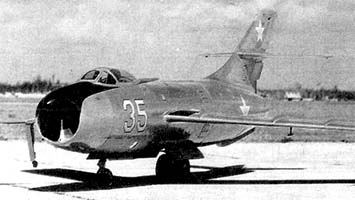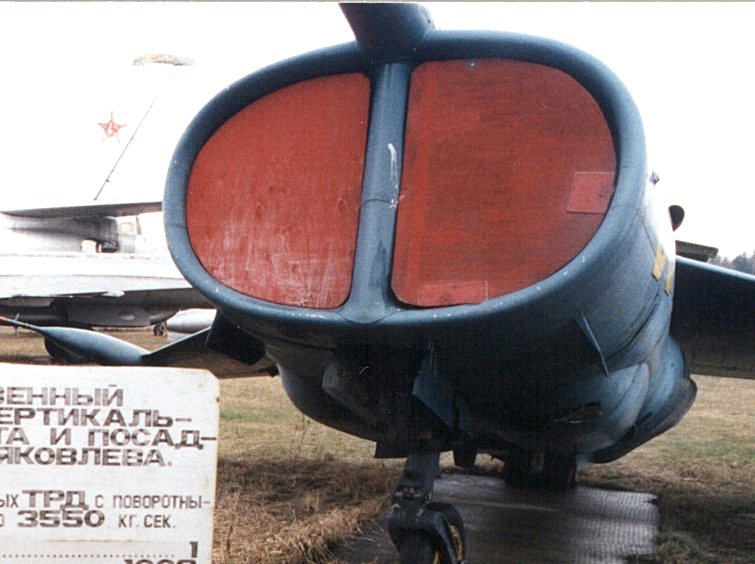Install the app
How to install the app on iOS
Follow along with the video below to see how to install our site as a web app on your home screen.
Nota: This feature may not be available in some browsers.
Je gebruikt een verouderde webbrowser. Het kan mogelijk deze of andere websites niet correct weergeven.
Het is raadzaam om je webbrowser te upgraden of een alternatieve webbrowser te gebruiken.
Het is raadzaam om je webbrowser te upgraden of een alternatieve webbrowser te gebruiken.
FORUMLEDEN met NOSTALGIE......"vreemde" kisten
- Topicstarter steffe
- Startdatum
- Status
- Niet open voor verdere reacties.
J
jeroen1971
Guest
Ooooooooh,... nou in dat geval zijn de antwoorden:
Mig-9? Nee.
Yak-50? Nee, (die had je afgelopen zaterdag in de Solid hangaar te Eindhoven kunnen zien).
Lavochkin LA-190? en Nee.

Mig-9? Nee.
Yak-50? Nee, (die had je afgelopen zaterdag in de Solid hangaar te Eindhoven kunnen zien).
Lavochkin LA-190? en Nee.
J
jeroen1971
Guest
Nog steeds blijft het antwoord: Nee 
J
jeroen1971
Guest
En een Mig-21 heeft ook een heeeeeele ander intake (rond met punt erin).
Het is iig een Yak, anders is de vaart er wel helemaal uit
Het is iig een Yak, anders is de vaart er wel helemaal uit
J
jeroen1971
Guest
Oh gelukkig,... ik dacht dat ik het straks voor moest gaan zeggen 
J
jeroen1971
Guest
Ships hoe heet dat ding nou ook alweer ? ? ?
James bond heeft in de Jet uitvoering hiervan gevlogen.
Denk denk denk denk,........ en dat op een zondag
James bond heeft in de Jet uitvoering hiervan gevlogen.
Denk denk denk denk,........ en dat op een zondag
prop-er
Forum veteraan

Bede BD-5
The Bede BD-5 is a small, single-seat homebuilt kit aircraft that was introduced in the early 1970s by Bede Aircraft Corp. It was designed by Jim Bede. It is a pusher aircraft design, with the engine installed in a compartment in the middle of the fuselage, and a propeller in the rear. Over 5,000 kits were shipped, but few were actually completed due to the company's bankruptcy in the mid-1970s, brought on by the failure to deliver a reliable engine for the design.
Development
The first model was the BD-5A, with an extremely short 14-foot (4.27 m) wingspan which made the aircraft extremely hard to fly except for the most experienced pilots.
The BD-5B increased the wingspan to 21 feet (6.40 m), which greatly improved the handling of the little bird. The BD-5D was to be the FAA-certified model of the aircraft, but certification was never completed and it never entered production. The BD-5S was a one-of-a-kind sailplane model which was never produced due to an unimpressive glide ratio.
BD Micro Technologies, a company operating out of Siletz, Oregon, designed the BD-5TP, a turboprop version of the BD-5 using a modified Solar/Hamilston Sundstrand T62 turbine engine mated to a custom-designed mechanically-controlled variable-pitch propeller.
Guinness Record Holder, The World's Smallest Jet, N3038VThe BD-5J is the jet version of the aircraft, the result of mating the BD-5 fuselage and a shortened 17-foot (5.18 m) wingspan with the Microturbo TRS-18 turbojet engine, manufactured by Microturbo in Toulouse, France, and by Ames Industrial in the United States under license from Microturbo. The aircraft was featured in the first few minutes of the James Bond movie Octopussy starring Sir Roger Moore. J.W. "Corkey" Fornof was the stunt pilot who performed the scene in which the aircraft (identified in the credits as the Acro Star) flew through a hangar. An example of the BD-5J currently based in San Juan, Puerto Rico holds the Guinness record for the World's Smallest Jet aircraft. Airframe kits for this tiny jet are still available from BD Micro Technologies and Alturair in San Diego, California, but the engines are much harder to find, as Microturbo no longer sells them for man-rated applications.
Surviving Aircraft
As of 2002, there were an estimated 150 BD-5's in airworthy condition [1].
A BD-5 is on display at the Steven F. Udvar-Hazy Center, an annex of the National Air and Space Museum at Washington Dulles International Airport in Chantilly, Virginia.
The BD-5J known as the "Bud Light Jet" suffered an engine compartment fire after a fuel flow sensor burst, and the aircraft was lost. The pilot bailed out of the aircraft after trading speed for altitude, and was unharmed.
A BD-5J crashed at Carp Airport west of Ottawa on June 16, 2006, while practicing for an airshow to take place the next day. The pilot, Scott Manning was killed in the accident. [2]
The BD-5J is now certified as a cruise missile surrogate, and operates as the Smart-1 (Smart Manned Aerial Radar Target, Model 1). The aircraft's radar return is so small, and the operational capabilities and performance of the tiny jet so well matched to those of cruise missiles, that it makes a perfect substitute as a training aid for all branches of the US Armed Forces.
Well known airshow pilot Chuck Lischer of Cameron Park, California died in an accident involving a Smart-1 crash on June 27, 2006. The aircraft crashed into a wooded area short of the runway at the Ocean City Municipal Airport in Ocean City, Maryland. Five days earlier, Lischer had flown three of five sorties over Washington, D.C. in homeland defense exercises testing ground sensors.
Specifications (BD-5B)
General characteristics
Crew: One Pilot
Length: 12 ft (3.88 m) to 13.5 ft (4.11 m) w/stretch kits
Wingspan: 14 ft (4.26 m) to 21 ft 6 in (6.55 m)
Height: 5 ft 2 in (1.6 m)
Wing area: Depends on wing used (-5A, -5B or -5J)
Empty: 358 lb (178 kg) and up
Loaded: 700 lb (340 kg) to 1100 lb (530 kg)
Maximum demonstrated takeoff weight (turbine): 1100 lb (530 kg)
Powerplant: Various reciprocating engines, from Rotax to Turbo Honda; turboprop with modified Solar T62; jet with Microturbo Couguar or TRS-18
Performance
Maximum speed: 200+ mph (320+ km/h) recip, 300 mph (500 km/h) jet
Range: 720+ miles (1,152+ km) recip, 300+ miles (500 km) jet
Service ceiling: 12,000 ft (3,658 m) recip, 23,000 ft (7,010 m) jet
Rate of climb: 1,900 ft/min (579 m/min) recip, 4,000 ft/min (1,219 m/min) jet
Wing loading: Varies depending on wing selected and aircraft weight
J
jeroen1971
Guest
juist,... die dus  i knew it
i knew it  (alleen was ik niet snel genoeg
(alleen was ik niet snel genoeg  )
)
Toon Jacobs is een BD-5 aan het bouwen met turbo-prop zou volgend jaar waarschijnlijk klaar zijn om te vliegen vermoedelijk PH-...
note: Toon heeft al een speed canard, cri-cri, potier 1 en potier 2 , slepkev storch, renagate en een zelfbouw Heli op EBZW staan. Het project na de BD-5 zou een ongeveer 75procent P51 zijn
ps hij bouwd zijn echte vliegtuigen sneller dan ik (en menig andere) zijn modellen bouwd.
note: Toon heeft al een speed canard, cri-cri, potier 1 en potier 2 , slepkev storch, renagate en een zelfbouw Heli op EBZW staan. Het project na de BD-5 zou een ongeveer 75procent P51 zijn
ps hij bouwd zijn echte vliegtuigen sneller dan ik (en menig andere) zijn modellen bouwd.
Die is niet zo heel moeilijk, het is de Saunders Roe SR45 Princess.
Op de Sruce Goose na de grootste vliegboot ter wereld. Er werden slechts 3 stuks gebouwd waarvan er maar één (deze) ook echt gevlogen heeft. Ze waren al "verouderd" op het moment dat ze gebouwd werden. Ook het feit dat er flinke problemen waren met de tandwielkasten voor de binnenste 8 motoren en props speelde een belangrijke rol in de beslissing om de verdere ontwikkeling te stoppen.
Toch is dit geen misselijk vliegtuig met z'n 10 turboprop motoren van elk 2386kW! Men is met het ontwerp begonnen in 1946 en het eerste (en dus enige) vliegtuig vloog voor het eerst in 1952. Het is alleen voor promotie doeleinden gebruikt want de moderne "landvliegtuigen" hadden gewonnen ondanks dat deze bij lange na niet in staat waren om evenveel passagiers te vervoeren als de Saro Princess.
De Princess was ontworpen als transatlantisch vliegtuig voor maximaal 220 passagiers en het maximale vlieggewicht was maar liefst 159 ton!

Ik ga op zoek naar een nieuwe opgave.
Op de Sruce Goose na de grootste vliegboot ter wereld. Er werden slechts 3 stuks gebouwd waarvan er maar één (deze) ook echt gevlogen heeft. Ze waren al "verouderd" op het moment dat ze gebouwd werden. Ook het feit dat er flinke problemen waren met de tandwielkasten voor de binnenste 8 motoren en props speelde een belangrijke rol in de beslissing om de verdere ontwikkeling te stoppen.
Toch is dit geen misselijk vliegtuig met z'n 10 turboprop motoren van elk 2386kW! Men is met het ontwerp begonnen in 1946 en het eerste (en dus enige) vliegtuig vloog voor het eerst in 1952. Het is alleen voor promotie doeleinden gebruikt want de moderne "landvliegtuigen" hadden gewonnen ondanks dat deze bij lange na niet in staat waren om evenveel passagiers te vervoeren als de Saro Princess.
De Princess was ontworpen als transatlantisch vliegtuig voor maximaal 220 passagiers en het maximale vlieggewicht was maar liefst 159 ton!

Ik ga op zoek naar een nieuwe opgave.
Dit is de volgende opgave. Het is een vrij bijzonder vliegtuig waarvan er nog vrij veel gebouwd zijn, meer wil ik er niet over zeggen.


ik kan de achterkant niet goed zien, maar het lijkt er inderdaad op dat je gelijk hebt! is dit een trainer kist voor de legeropleiding voor piloten van toen? (instructeur achterin)
*zoeken* nee, wel 1 tweezits-mustang, maar daar lijkt de kap meer op een zero, en ook een hoop andere dingen anders.. nouja, ik weet et niet..
*zoeken* nee, wel 1 tweezits-mustang, maar daar lijkt de kap meer op een zero, en ook een hoop andere dingen anders.. nouja, ik weet et niet..
- Status
- Niet open voor verdere reacties.







